◆Concept for Slow-Walking◆
Walking southward from the Castle Park and after passing Chitosebashi bridge over Metobagawa, you would find the west entrance to Nakamachi street.
Though the contemporary buildings are standing along the boulevard near Matsumoto station, the townscape suddenly change just after walking in Nakamachi street.
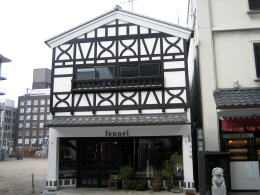
▲Shop in German old houseドstyle
▼Popular sweet shop
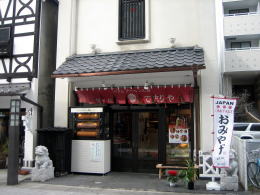
After passing Chitose-bashibrighe over Metoba-gawa, having began walking from the castle park, we find the west-end entrance of Nakamachi along the boulebvard.
Though many contemporary buildings are standing on the main street, we would find another feature of the townscape, getting into Nakamchi street.
The street has been formed in such a way that the tourists would walk slowly and to enjoy the town-view, as the sidewalk-pavement is made on both side of the street and car-traffic is limited. The roadway for cars is restricted narow and only one-way traffic in crawl is permitted.
Though it is a shopping town, they give priority to tourists walking and watching it slowly.
The houses facing the street are limited their heights and almost unified in the mode of white mud-walled warehouse. The display or decoration of shop is restrained.
◆Nakamachi-Kaikan Hall◆
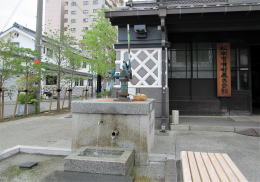
▲Water-well of Kura :
Famous well suitable to a factory-warehouse of Sake brewer
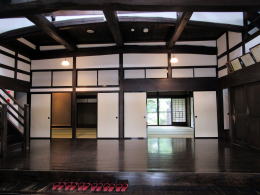
▲Wooden flooring in the hall and curved beams
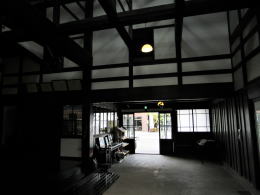
▲Stair-well above the earth ;
Mud-walls and high ceiling have a nice sound effect
Kura-chic hall, as a town hall, is the place where some events are usually held and people take intercourse with tourists. In Japanese Kura means a mud-walled warehouse.
Its house with gray mud-wall, which once was a main warehouse of a Sake brewer, was moved from the near town and rebuilt here.
Some kinds of workshop, for example for handcraft-learning, the town-meetings, the exihibitiosn or the oncerts are held here.
The hall is very suitable for the town in which the mud-walled warehouse mode is a unified concept of town-forming.
◆Old and Stylish Townscape◆
Nakamachi-dori town has developed as the commercial complex along Zenkoji-kaido near the castle. But as the town has been lying outside of the outer- most moat, it was not included in the down-town and relatively free development of commercial town was permitted.
Thus it could avoide the turmoils and the destructions in Meiji Revolution and has kept the traditional townsape. On the other hand, the zone immediately down the castle omly very a few houses has been kept.
On Nakamachi street many old shop-houses that was founded from late Edo period to Taisho period has been conserved well.
|
